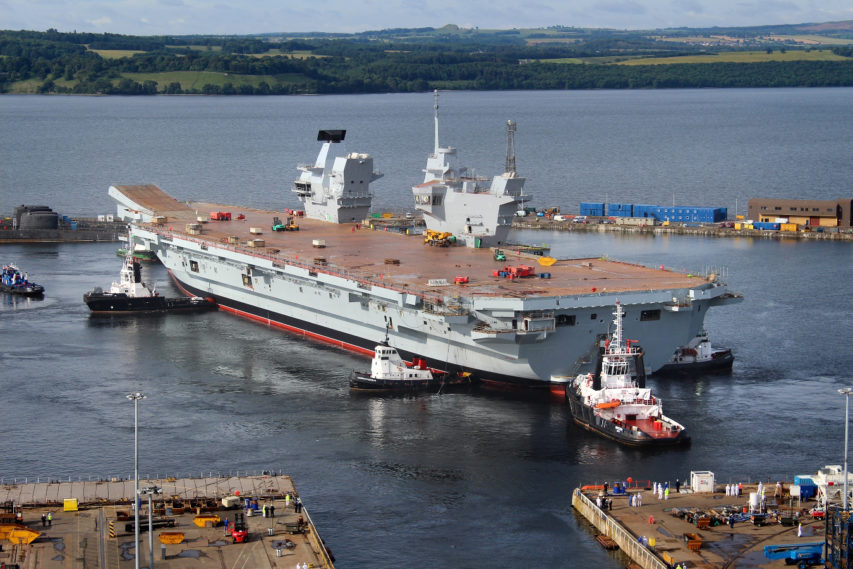
The Royal Navy’s largest ever warship HMS Queen Elizabeth is gently floated out of her dock for the first time in Rosyth, Scotland in July 2014. In an operation that started earlier that week, the dry dock in Rosyth near Edinburgh was flooded for the first time to allow the 65,000 tonne aircraft carrier to float. It then took only three hours to carefully manoeuvre HMS Queen Elizabeth out of the dock with just two metres clearance at either side and then berth her alongside a nearby jetty. Teams continued to outfit the ship and steadily bring her systems to life in preparation for sea trials in 2016. The dock she vacated will be used for final assembly of her sister ship, HMS Prince of Wales.
Source: Wikimedia.
The Royal Navy’s newest aircraft carrier is scheduled to be brought into commission in May this year:
The first new Royal Navy aircraft carrier in thirty years is nearing sea trials. After a brief absence from the world of fixed-wing naval aviation the Royal Navy’s brand new flattop HMS Queen Elizabeth and its sister ship, Prince of Wales, will soon sail the seas, their decks full of new F-35 Joint Strike Fighters. The result will be the most powerful “Senior Service” in generations.
The Royal Navy was one of the first naval warfare forces to explore the nascent world of naval aviation. HMS Argus, commissioned in September 1918, was arguably the first aircraft carrier with a full-length flight deck. The UK was one of the major aircraft carrier powers throughout World War II, and continued to operate carriers in the postwar period.
By 1982, the Royal Navy had committed to building three Invincible-class carriers. Somewhat scaled back from earlier ships, and dwarfed by the U.S. Navy’s Nimitz-class carriers, the Invincible class was more suited to antisubmarine warfare duties against the Soviet Navy, keeping the sea lines of communication between North America and Europe clear in the event of World War III. The Invincibles could sail with a complement of up to twenty-two aircraft, typically a mixture of Sea Harrier fighters and Sea King helicopters.
The 1982 Falklands War demonstrated the shortcomings of relying upon such small carriers. HMS Invincible, along with the older HMS Hermes, struggled to provide early warning and combat air patrol over the UK task force sent to reclaim the islands, and were unable to prevent Argentine air power from sinking six friendly warships and supply ships and damaging another nine.
In 2007, despite the general downturn in the size and scope of the navy, plans were announced in 2007 to construct two brand-new aircraft carriers. Each would be stocked with brand-new F-35 Joint Strike Fighters and helicopters, and would be up more than three times larger than their predecessors by displacement. The carriers, Queen Elizabeth and Prince of Wales, would be the largest warships ever built by the UK, bigger even than the World War II battleship HMS Vanguard.
Unfortunately, in order to free up funding for the new carriers the older ships had to be retired, and decommissioning of the Invincible class carriers and their Sea Harrier jets during the 2010s was a huge blow to the Fleet Air Arm. The three warships were broken up for scrap, and the remaining Harrier jets, which by now included RAF Harriers, were purchased by the U.S. Marines to provide spare parts for their own fleet of AV-8B Harriers.



